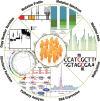Analysis of next-generation genomic data in cancer: accomplishments and challenges
- PMID: 20843826
- PMCID: PMC2953747
- DOI: 10.1093/hmg/ddq391
Analysis of next-generation genomic data in cancer: accomplishments and challenges
Abstract
The application of next-generation sequencing technology has produced a transformation in cancer genomics, generating large data sets that can be analyzed in different ways to answer a multitude of questions about the genomic alterations associated with the disease. Analytical approaches can discover focused mutations such as substitutions and small insertion/deletions, large structural alterations and copy number events. As our capacity to produce such data for multiple cancers of the same type is improving, so are the demands to analyze multiple tumor genomes simultaneously growing. For example, pathway-based analyses that provide the full mutational impact on cellular protein networks and correlation analyses aimed at revealing causal relationships between genomic alterations and clinical presentations are both enabled. As the repertoire of data grows to include mRNA-seq, non-coding RNA-seq and methylation for multiple genomes, our challenge will be to intelligently integrate data types and genomes to produce a coherent picture of the genetic basis of cancer.
Figures


References
-
- Bentley D.R., Balasubramanian S., Swerdlow H.P., Smith G.P., Milton J., Brown C.G., Hall K.P., Evers D.J., Barnes C.L., Bignell H.R., et al. Accurate whole human genome sequencing using reversible terminator chemistry. Nature. 2008;456:53–59. doi:10.1038/nature07517. - DOI - PMC - PubMed
-
- Koboldt D.C., Chen K., Wylie T., Larson D.E., McLellan M.D., Mardis E.R., Weinstock G.M., Wilson R.K., Ding L. VarScan: variant detection in massively parallel sequencing of individual and pooled samples. Bioinformatics. 2009;25:2283–2285. doi:10.1093/bioinformatics/btp373. - DOI - PMC - PubMed
-
- Li H., Handsaker B., Wysoker A., Fennell T., Ruan J., Homer N., Marth G., Abecasis G., Durbin R. The Sequence Alignment/Map format and SAMtools. Bioinformatics. 2009;25:2078–2079. doi:10.1093/bioinformatics/btp352. - DOI - PMC - PubMed
-
- Li R., Li Y., Kristiansen K., Wang J. SOAP: short oligonucleotide alignment program. Bioinformatics. 2008;24:713–714. doi:10.1093/bioinformatics/btn025. - DOI - PubMed
Publication types
MeSH terms
Grants and funding
LinkOut - more resources
Full Text Sources
Other Literature Sources
Research Materials

